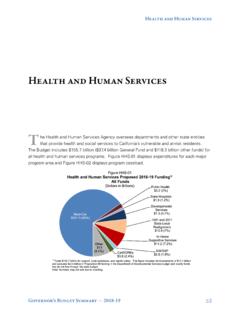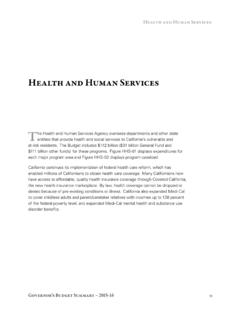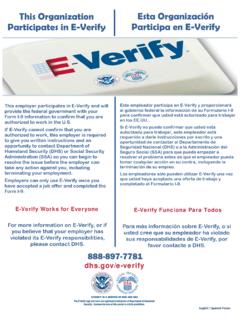Transcription of H˜˘¯˚Ô E¸Ï˝ˇÌ˜ÒÚ - California Budget
1 H E California s approach to budgeting for higher education has long been guided by principlesarticulated in the 1960 Master Plan for Higher Master Plan differentiatedfunctions across segments; set standards for access to postsecondary education, relying onthe transfer function from the community colleges to thefour-yearsegments to promote broadaccess; and created an expectation of low costs of principles remainrelevant 1960, the state faced the challenge of a rapidly growing , the state is confronting different, but equally pressing, state Budget faces significant constraints and across income levels and racial and ethnic groups varies, limiting economic andsocial mobility for many the nature of labor markets change, adults needaccess to education and training for new Budget maintains the current approach to budgeting for higher education and continues thegrowth in funding for higher education that started with the passage of Proposition 30 Administration expects the segments will continue to make progress inimplementing practices that recognize both the principles of the Master Plan and strong The Budget proposes total funding of $ billion($ billionGeneral Fund and local propertytax and $ billionother funds)
2 For higher total reflects growth of$ million($ millionGeneral Fund and local property taxes and $271 millionotherhDsjD82tKrgAH E G ' B S 2018-1939funds) compared to additional detailabout funding for higher L -T A F S Since the passage of Proposition 30 in 2012, the state has funded along-termplan for both theUniversity of California (UC) and the California State University (CSU), increased resourcesavailable to California Community Colleges (CCC) consistent with growth in the Proposition 98minimum guarantee, and expanded the Cal Grant the increasesproposed by the Administration in2018-19, funding since2012-13forthe UC will have grown by $ billion, for theCSU by $ billion, and for the CCCs (excludingfunding for the Adult Education Block Grant) by $ annual increases have allowed the universities to plan their programs over CCC growth has increased the number of course offerings, which weresignificantly reduced during Budget cuts of the Great community colleges alsoadopted a formula that prioritizes growth funding to districts with the greatest unmet E 40G ' B S 2018-19 Additionally, community colleges have received $ millionProposition 98 General Fund inincreased base funding in recognition of increased operating expenses, primarilyin the areas offacilities, employee benefits, professional development, , since2012-13total funding for the Cal Grant Program will have grown by $623 million, A While the state pays a portion of the instructional costs for each student attending a Californiapublic college or university.
3 The state s Cal Grant program provides additional financial aid fortuition, fees, or other costs of attendance for students with demonstrated programis an entitlement for students who meet eligibility criteria, with students who are ineligible forthe entitlement program still able to compete for additional current practice, forstudents attending the UC and the CSU, the amount of funds a student receives for tuition islinked to the amounts charged by those tuition awards for students attendingother types of institutions are set in the UC and the CSU are considering tuition increases UC Office of thePresident has suggested that it will present another ($288) tuition increase to theBoard of Regents later in CSU Chancellor's Office has indicated that another4-percenttuition increase ($228) is under consideration for presentation to the Board tuition increases would grow Cal Grant costs for UC and CSU students in2018-19beyond the costs reflected in the Administration remains concernedabout the impact of tuition increases on lower income students and families and believes moremust be done to reduce the universities'cost reforms should beimplemented before the segments consider charging students Administration has worked to reduce the overall cost structure of higher education throughvarious remaining flat since2011-12, the UC Board of Regents and the CSUB oard of Trustees raised tuition in2017-18to $11,442 annually at UC (an increase of $282, percent) and $5,742 annually at the CSU (an increase of $270, or5 percent).
4 Withenrollment fees of $46 per unit, the CCC system is thelowest-pricedhigher education systemin the , approximately 65 percentof all CCC enrollment fees are waived,providing atuition-freeeducation to about 50 percent of legislation, Chapter735, Statutes of 2017 (AB 19), enablesCCCs to waive some or all of the $46 per unit fee for allfirst-timeresident students enrolled in 12 units or more per semester during their first fees are not waived, a CCCstudent can complete the 60 units necessary to obtain anassociate degree or transfer to afour-yearinstitution for less than $3,000 in tuition, although thetotal cost of attendance is more significant, including books, transportation and living E G ' B S 2018-1941 Currently, students attending private nonprofit institutions andfor-profits accredited by theWestern Association of Schools and Colleges (WASC) receive up to $9,084 annually for tuition,and students attending otherfor-profits receive $4, to existing law, the award forthe nonprofit institutions andWASC-accredited,for-profitinstitution s is scheduled to decreaseto $8,056 beginning nonprofit institutions, the Budget proposes to maintain theaward at $9,084, with a new requirement that, beginning in2019-20, the sector admits at least2,500 students who have earned Associate Degrees for Transfer from the community collegesand are guaranteed junior amount will ramp up to 3,000 students in thefollowing C C TheCCCs arethe largest system of higher education in the nation, serving roughlyone-quarterof the nation's community college students, or approximately CCCsprovide basic skills, vocational, and undergraduate transfer education with 72 districts, 114campuses, and 78 educational.
5 The community colleges awarded over81,000 certificates and 139,000 degrees and transferred over 106,000 students S The state has made significant investments to improve and expand student success programsand shorten a student s time to complete a degree or includes $285 millionforthe Student Success and Support Program, whichprovides education planning services formatriculated students, and $155 millionto mitigate disproportionate impacts on access andachievement in underrepresented 2017 Budget Act also included $150 million inone-timefunding forCCCs to develop guidedpathway guided pathway is an integrated,institution-wideapproach focused onstudent success, including clear pathways for students to complete their firstrelease of the funding for guided pathways is planned for April 114communitycolleges participated in guided pathways workshops organized by the Chancellor s OfficeInstitutional Effectiveness Partnership Initiative (IEPI).
6 With ongoing resources of $20 million,IEPI provides training to community college staff to promote strategies to remove barriers tostudent Administration has supported initiatives to improve basic skills courses and reformplacement policies as a way to improve student 2015 Budget Act provided $60million Proposition 98 General Fund to assist community colleges in improving delivery of basicskills instruction by adopting or expanding the use ofevidence-basedmodels of placement,hDsjD82tKrgAH E 42G ' B S 2018-19remediation, and student , Chapter 745, Statutes of 2017 (AB 705), requires allcolleges to use multiple measures of assessment, including a student s high school grades orgrade point average, when placing students in English and math Administrationsupports better alignment across the segments to make students transitions more efficient across , the Administration has encouraged theuse of transfer the Associate Degree for Transfer, students have a clearerpathway through the community colleges and are guaranteed to enter the CSU with , a key part of the Governor s 2015 agreement with theUC was improvingtransfer to the UC by articulating similar transfer Budget proposes requiring,beginning in2019-20, private nonprofit institutions to admit at least 2.
7 500 students who haveearned transfer degreesfrom the community colleges and guarantee junior statealso expanded dual enrollment opportunities to allow high school students to takecollege-levelcourses at their high school or at a community college campus, in anticipation of improvingcompletion rates , approximately 24,000 students participated indual enrollment S N S -F F F In July of 2017, the CCC Board of Governors adopted an ambitious strategic plan, theVision forSuccess, to improve community college student plan calls for the system tosignificantly increase completion and transfer rates, decrease excess units taken by students,increase the number of students in career technical education programs who are employed intheir field of study, and eliminate achievement Administration applauds the systemfor adopting racial, ethnic and regionalgoals and reinforcing s proposed investments in the CCCs focus on advancing the system s new strategicplan goals and building upon thestudent-successinvestments of prior existingenrollment-basedCCC apportionment funding model does not appropriately reflectthe Board of Governor'sVision for Successor the state s priorities to better serve students andeliminate equity funding colleges based primarily on enrollment, the current fundingformulaencourages districts to strictly prioritize student access without regard for studentsuccess suchas timely completion and better serving underrepresented proposes a new funding formula for general purpose apportionments thatencourages access for underrepresented students, provides additional funding in recognition ofthe need to provide additional support forlow-incomestudents.
8 And rewards colleges progresson improving student success the formula, no district would receive lesshDsjD82tKrgAH E G ' B S 2018-1943funding than is currently proposed formula incorporates the following corecomponents: BaseGrant Eachdistrict would receive a base grant based on to theexisting funding formula, aper-Full-TimeEquivalent Student (FTES) funding rate would beapplied across all districts. SupplementalGrant Eachdistrict would receive a supplemental grant based on thenumber oflow-incomestudents that the district , the supplementalgrant would reflect two factors: (1) enrollment of students who receive a College PromiseGrant fee waiver (formerly known as the Board of Governors Waiver) and (2) enrollment ofstudents who receive a Pell grant. Student Success IncentiveGrant Eachdistrict would receive additional funding for thenumber of students who meet the following metrics: (1) the number of degrees andcertificates granted and (2) the number of students who complete a degree or certificate in3 years or grant would also include additional funds for each Associate Degree forTransfer granted by the college.
9 Hold HarmlessProvision Duringthe first year of implementation, each district would beheld harmless to the level of funding that the district received , thehold harmless provision would be calculated each year using the2017-18per-FTES ratemultiplied by the district s new proposal assumes that approximately 50 percent of funding would be distributed initially asthe base grant, 25 percentdistributed as part of the supplemental grant, and 25 percentdistributed as part of the student success incentive to the adoption of anew funding formula, the Budget proposes requiring community colleges to incorporate thegoals of theVision for Successwithin each college's educational master plan andaligning eachcollege's budgetwith theireducational master , the Administration expects theChancellor s Office to consult with stakeholders and develop a proposal for consideration withinthe May Revision that would consolidate categorical goal is to improve theincentives for districts to focus on improving student success while providing districts with localflexibility to do A O C Despite the vast number of courses offered by community colleges, there are millionCalifornians in the prime working ages between 25 and 34 who have only a highschool diploma or some college but no these Californians, approximately 48 percentare Hispanic and nearly half are , considering 35 to 65 year old adults, millionhDsjD82tKrgAH E 44G ' B S 2018-19 Californians have only a high school diploma or some college but no adults areat great risk during economic downturns and from the impact of automation in the.
10 Many Californians access online credentials, certificates, and associatedegrees atnon-public,non-accredited, orout-of-stateinstitutions, which are typicallymuchcostlier than California community colleges and often have poor student students have accessed higher education, but did not finish their degree and areburdened by student loans and other types of debt, limiting their ability to access the coursesneeded to advance in their employment or stay relevant in their to theGeorgetown University Center on Education.



















